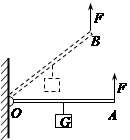问题
填空题
如图所示,轻质杠杆OA中点悬挂重为60N的物体,在A端施加一竖直向上的力F,杠杆在水平位置平衡,则力F的大小是 _,保持F的方向不变,将杠杆从A位置匀速提升到B位置的过程中,力F将 _(选填“变大”、“变小”、或“不变”)。

答案
30N 不变
题目分析:由题意可知,阻力臂是动力臂的一半,所以由F1 L1=F2 L2可知动力是阻力的一半即为30N。因为动力和阻力的方向不变,所以将杠杆从A位置匀速提升到B位置的过程中,动力臂和阻力臂的比也不变,由F1 L1=F2 L2可知,力F将不变。
